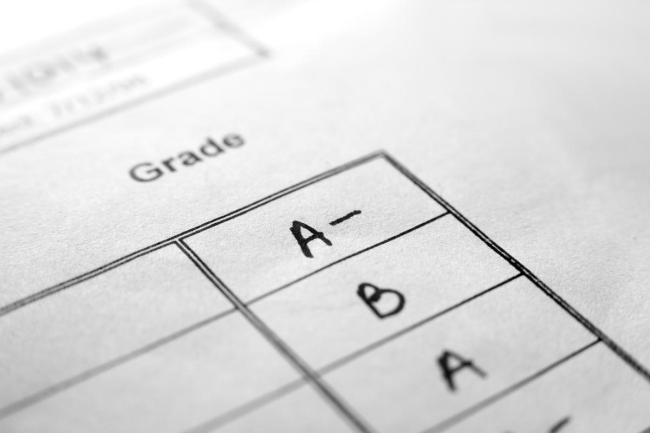You have /5 articles left.
Sign up for a free account or log in.

New research finds that grade inflation is contributing to higher graduation rates.
jaker5000/E+/Getty images
Researchers looking at the link between grade inflation and college completion rates found that grade inflation explains much of the increase in college graduation rates since 1990.
“As with many policy levers, grade inflation has costs and benefits,” the authors write in a new article published today in Education Next, a journal focused on educational reform. “We show that it led to an increase in college graduation rates. However, there may be deleterious effects of grade inflation if it changes what is learned in college. Our work highlights the importance of thinking of grading policy as a key decision that colleges make.”
The research from Jeffrey T. Denning, an associate professor of economics at Brigham Young University, and four other researchers from Brigham Young, Purdue and Stanford Universities, is also the basis for a forthcoming article in the American Economic Journal: Applied Economics.
The authors analyzed two different longitudinal federal studies and found that students who were scheduled to graduate high school in 2004 were 3.8 percentage points more likely to earn a bachelor’s degree within eight years than students scheduled to graduate high school in 1992.
In examining various student and institutional characteristics that could explain the increase in completion rates -- among them changes in enrollment, levels of student preparedness and per-student instructional expenditures -- they found that those factors would predict decreases in college completion rates rather than the observed increases.
But the authors found that students who graduated more recently had higher GPAs, a conclusion they reached through analysis of four different data sources.
They found, for example, that average GPAs for first-year students at a group of nine major public research universities increased from 2.68 to 2.79 between 1990 and 2000.
And they found that GPAs for students at an unidentified public liberal arts college increased from 2.77 in 2001 to 3.02 in 2012. Over that same time, graduation rates for the public liberal arts college grew from 83.1 to 85.9 percent.
The authors dug deeper in identifying two required freshman science classes at the public liberal arts college where final exams have remained nearly identical over time.
“In looking at results on those tests, controlling for demographics and exam and course fixed effects, we find that entering school one year later corresponds to a large and statistically significant increase of 0.053 grade points,” Denning and his co-authors wrote.
“In other words, students with the exact same score on the exact same final exam earned better grades in later years. Given the close relationship between GPA and graduation, our finding that grades are increasing over time, even when student characteristics and performance on identical comprehensive final exams are accounted for, suggests that it’s getting easier to earn a degree at the public liberal arts college we study. And, given the similar trends we see between this one school and the nationwide samples from 1988 and 2002, we believe that this discovery is likely informative of broader trends.”
Denning, one of the authors, said in an interview that people often assume he and his coauthors think this either a very good or -- more often -- a very bad thing.
"I think we’re a little more agnostic about it," he said. "College graduation looks like it went up as a result and graduating from college has been shown as a good thing and [grade inflation is] a low-cost way to do it in that there’s no monetary cost… On the other hand, if it makes it so students are less likely to invest in college—grades often work as an incentive to study and work hard—then maybe students will learn less. Or if it degrades the signal that a college degree conveys to employers that could be bad, too.”
Denning and his co-authors wrote that “it is hard to know for sure” why grade point averages increased from the 1990s. They observed that instructors may have incentives to give higher grades in order to earn better teaching evaluations and that departments known for high grading may attract larger enrollments.
They also argued that the “recent policy focus on college completion seems a likely contributor to increases in average GPAs. As schools and departments face increased scrutiny and, in some cases, increased funding incentives, they may respond by increasing graduation rates. Changing standards of degree receipt is a low-cost way to increase graduation rates. And in fact, graduation rates increased sharply at public four-year schools and community colleges, which rely on tax dollars and can be affected by states’ performance-based funding rules.”
The research comes in the context of increased attention to the issue of college completion at the federal level.
The most recent version of the Build Back Better legislation being championed by the White House would allocate $500 million for grants to institutions to encourage college retention and completion. The legislation specifies that priority for the “retention and completion grants” should be given to institutions “that propose to use a significant share of grant funds” to improve enrollment, retention, transfer, completion or labor market outcomes among “students of color, low-income students, students with disabilities, students in need of remediation, first generation college students, student parents, and other underserved student populations.”
Tamara Hiler, director of education at Third Way, a center-left think tank that is championing the completion grants, said the focus on completion is critically important.
“While I do not doubt the authors’ findings regarding grade inflation connected to some on-the-ground shifts in the late 1990s and early 2000s that may have altered the behavior of some professors to increase their grades, I think it is quite a large jump to further connect those findings to the broader completion efforts we are seeing policy makers push for today,” Hiler said via email.
“Despite minimal upticks in completion rates, the reality is that we still have a college completion crisis,” she said. “That’s why it remains critically important for policy makers and institutions to focus on improvement along the entire postsecondary pipeline, including efforts to increase enrollment and completion. This also speaks to the importance of putting in place accountability systems or outcomes-based performance systems that include multiple measures, like looking at retention and completion numbers in conjunction with other post-enrollment outcomes like the earnings premiums of students beyond a high school degree or loan repayment outcomes. Doing so will ensure that institutions cannot just game one metric or become diploma mills in the hopes of looking good.”
Zachary Bleemer, a postdoctoral fellow for Opportunity Insights, a nonprofit organization based at Harvard University and focused on issues of economic opportunity, and a research associate at the Center for Studies in Higher Education at the University of California, Berkeley, echoed the argument made by Denning and his co-authors that grade inflation has benefits as well as costs.
“Many people focus on its costs -- that inflation may demotivate students and lead to less learning in school -- but Denning et al.’s nice study highlights a potential benefit: students with inflated grades may be less likely to drop out of college, which could mean that they learn more in college over all even if they learn less in each course,” Bleemer said. “The study doesn’t present smoking-gun evidence that grade inflation increases degree attainment, but the authors convincingly show that the recent rise in U.S. graduation rates may partly result from decreased educational standards.”








